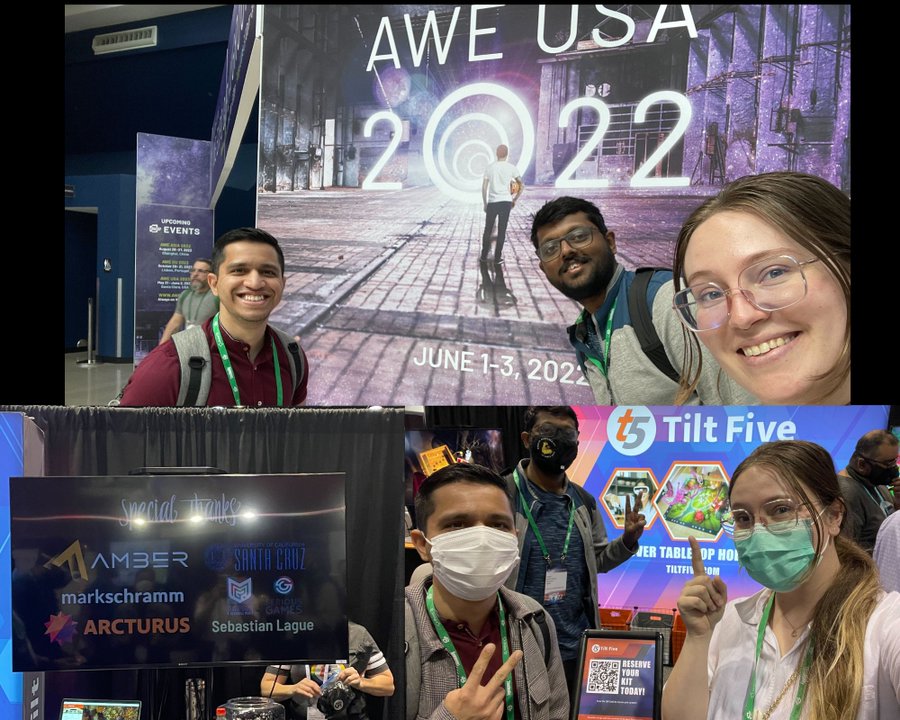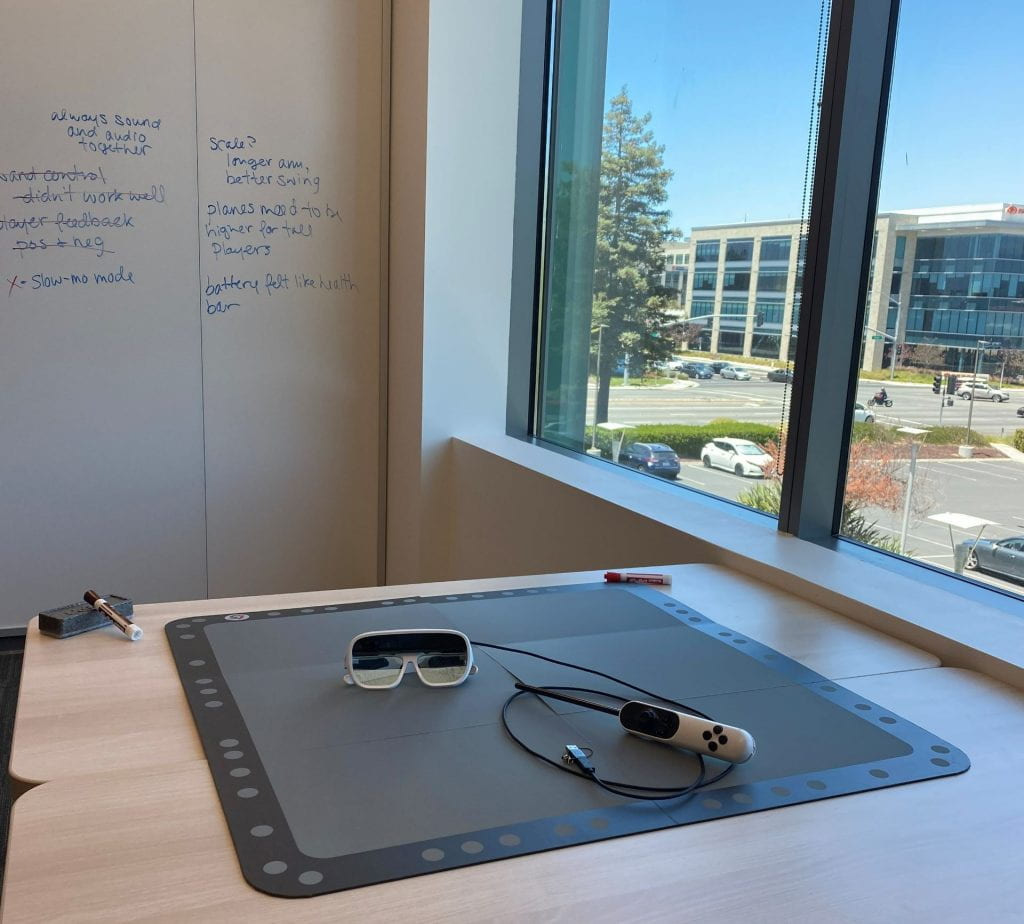In collaboration with Tilt Five (T5), two teams from the Games and Playable Media MS Program created working prototypes for the Tilt Five® augmented reality gaming system, which was displayed at the recent Augmented World Expo USA (AWE) 2022. We sat down with representatives from two of these teams, Jonathan Leland and Cassidy Landers, to hear what they had to say about the experience.
What made you decide to get involved with this project?
Jonathan: Last quarter MJ (Michael John, Vice Chair of the Games and Media MS Program) mentioned that Tilt Five would be giving our program some kits to work with, and since I had seen their demo last fall I was already intrigued. I am generally interested in unconventional approaches to game design and the related technical challenges. About midway through the spring quarter MJ announced that we could substitute one of our upcoming assignments with a Tilt Five project, and that it would coincide with their exhibition at an XR trade show in Santa Clara. Without thinking too much about what exactly that would entail I jumped at the opportunity.
Cassidy: I wanted to get involved with this project because, firstly, I had never worked on a project outside of your standard screen-based game. Secondly, how often does one get the opportunity to make something to be shown at such a huge expo?! I was really excited at the prospect of creating for Tilt Five’s hardware and working on something that would be experienced by so many people of differing backgrounds.
What was your game called, and what part did you play on the development team?
Jonathan: We created a game called Blow Away. My teammates were Jai Dodechani, Weiqiang Chen, and Yuxiao Wang. I was the team lead, and contributed to design, programming, and UI. My team’s first idea was a two-player competitive game where each player would push balls around an arena with wands that could apply force from a distance, like a leaf blower. When we realized that two players weren’t yet supported on one machine, we tried to adapt this idea for one player, coming up with something like pinball. Eventually we realized we wouldn’t have time to do this idea justice, so with only a week left we ended up pivoting to a simpler leaf blower game.

Photo: Cassidy and teammates Hanu and Aniruddha at AWE 2022.
Cassidy: Our team’s project was called Wrecking Crew. In our game, the player controls a crane with a wrecking ball and drives around a large city. The goal is to cause as much destruction and mayhem as possible within sixty seconds. We created Wrecking Crew as a team of seven: myself as project lead and designer, programmers Aniruddha Joshi, Hanu Kancharla, Eric Lu, Ben Rowland, and Lu Wang, and designer Payton Jian. It was great working in such a large team because we had so many differing ideas and perspectives that allowed us to try new things, like hiding a giant dragon in the sky above the player!
Did you interact with Tilt Five during this project? If so, was this your first time interacting with someone from the Games Industry on a project, and how was the experience different from what you’ve experienced in the classroom, generally speaking?
Jonathan: Yes, I interacted with some of the people from Tilt Five, mainly a producer. This was my first time interacting with someone from the game industry in this way – it was a really illuminating experience and sometimes quite challenging. The Tilt team people offered a lot of support for us, and some helpful ideas to nudge us in the most productive directions for our project, but eventually it also became clear that they expected a certain level of polish from this project that we weren’t quite prepared for. Up to this point we had only made quick prototypes for class assignments which didn’t need to be polished beyond communicating an interesting game idea. The Tilt Five team were very gentle and supportive, but we still felt a lot more pressure than we were used to getting in our first year of classroom studies. Pivoting to the leaf blower game was a crucial moment for us, because we realized we couldn’t deliver a polished pinball game, but we could polish a much simpler idea. It was a bit scary to tell the Tilt Five team about the pivot, but they were very understanding and supportive. I am actually quite proud of how our team handled this and how I communicated with Tilt Five.
Cassidy: We interacted quite frequently with Tilt Five during this process! It was our first time creating something with external stakeholders, so at first it was a bit daunting; however, the open communication between Tilt Five and our team led to an incredible support system and gave us an eagerness to take risks and try new and awesome things. If it wasn’t for the feedback and support of Tilt Five, our game would have ended up in a very different place. One of the things I learned from this was that frequent communication is crucial to making sure everyone involved in the project is happy and feels that their voice is heard.
Did you get a chance to attend AWE and see your project? If so, what was that experience like?
Jonathan: We did go to AWE. There was a lot of bluetooth interference on the expo floor, and since our game depended on bluetooth wand tracking, Tilt Five decided not to demo the game. At one point they did give it a try, and it worked, so we got to see one person play it. The expo was more focused on the business of XR, but it was still very cool to see all the exhibits.
Cassidy: The majority of our team ended up attending AWE to see our project and introduce it to attendees. This was a really exciting experience for several reasons, but especially because all of us worked so hard on it and got to see people having a great time with something we created. Even the attendees who didn’t consider themselves “gamers” enjoyed running around the city and breaking things (who wouldn’t?!). It was a really great experience to be able to introduce our game to attendees personally, answer questions, and hear their feedback directly.

Photo: Tilt Five took home the AWE 2022 Auggie Award for for “Best Game / Toy”
What was your biggest take-away from this experience? Do you think you will do more AR projects in the future?
Jonathan: I think the biggest take-away for me was experiencing what it was like to be a developer with a “publisher” keeping tabs on the project. I was very thankful that Tilt Five were so supportive, but it was still a lot of pressure that I did not anticipate. However, now that I have experienced this situation I feel much more prepared to deal with it in a more professional context. I also learned that developing for AR comes with so many unexpected challenges that change depending on the project. Approaching an AR game as if it was just a 3D game in a different context doesn’t quite work, so I learned a lot about how to quickly adapt design ideas on the fly, even when it means abandoning a lot of prior work. I would definitely be interested in developing more AR or XR projects in the future because there is so much potential for experimentation, but the experience also helped me appreciate how established the design methods are for flat screen games played with mouse and keyboard or controller.
Cassidy: My biggest takeaway from this experience is that it’s an entirely new world to develop for something as unique as the Tilt Five AR hardware – but in the best way! This project challenged what I knew about game design and made me consider perspectives and features that I hadn’t previously considered when working on more traditional experiences. such as a player’s height affecting how they perceive the game world. Overall, this was an incredible experience for all of us on Wrecking Crew!
We want to express special thanks to Hans ten Cate, Jeri Ellsworth, and Lee Perez for their tremendous support and generosity.
If your company has a novel game development system that you would like demoed, contact us at msgames@ucsc.edu. We’d love to hear from you and make your system the focus of our next group project!

